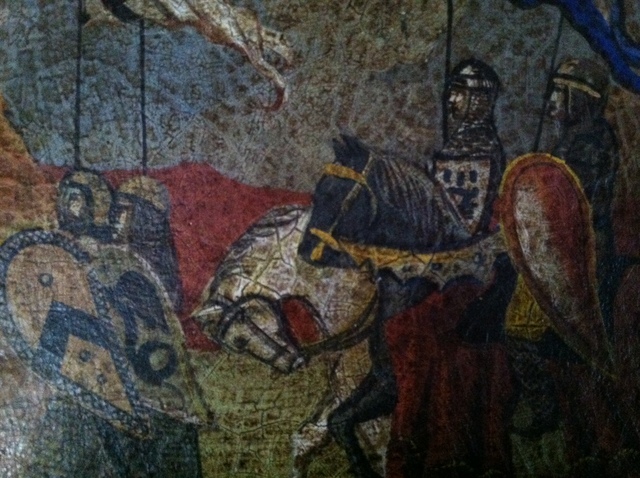In album: Perrefonds
Camelot) Original Renaissance "Master" Painting Depicting Perrefonds (Pierrefonds) 14th Century Hearldry. One Of The Earliest Painting Discoveries For Perrefonds. (Sept. 1st 2014) Confirmed (Sept. 2nd 2014) Perrefonds (Pierrefonds) with the silent letter i is reformed spelling that occurred in the 16th and 17th centuries. The painting is a Masterpiece discovery. (81.9cm X 107.3cm) Contact: dexxxaa@gmail.com or dexxxaa@earthlink.net
81.9cm X 107.3cm
Confirmed (Sept. 2nd 2014)
(Medieval Kite shield)
The so-called kite shield had mainly a flat design, as depicted in the Bayeux tapestry. The soldiers are shown using their shields as trays on which to set the cups and dishes. Sometimes, the shield was bowed, and might also have a projecting spike, as in the Great Seal of King Stephen. Generally, this was the favorite form until the end of the 12th century and began to be phased out at the end of that century, and had largely disappeared by the 14th century. (Wikipedia)
(Bayeux Tapestry)
The tapestry consists of some fifty scenes with Latin tituli (captions), embroidered on linen with coloured woollen yarns. It is likely that it was commissioned by Bishop Odo, William's half-brother, and made in England—not Bayeux—in the 1070s.
(Amphiptere)
An amphiptere is a winged serpent found very rarely in heraldry, though it does exist as a supporter and as a charge on a shield occasionally.
(Cherevon)
The Chevron occurs very frequently in British and French heraldry.
(Heraldry)
A chevron is one of the ordinaries in heraldry, one of the simple geometrical figures which are the chief images in many coat of arms. Chevrons appeared early in the history of heraldry. (Wikipedia)
(Helmet Armory)
Helmets worn in painting ca. 13th, 14th & 15th Centuries.
Comments
 Add Comment
Add Comment
Please login to add comments!



